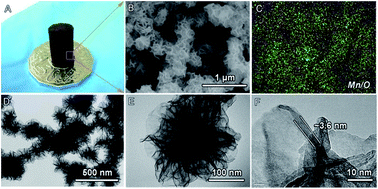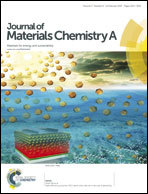Three-dimensional MnO2 ultrathin nanosheet aerogels for high-performance Li–O2 batteries†
Abstract
Two-dimensional (2D) ultrathin nanocrystals represent a family of emerging nanomaterials with many proposed applications; however, the interlayer re-stacking between sheets greatly decreases the performance during practical operation. This work demonstrates a facile strategy to solve this challenging problem by rational assembly of 2D nanocrystals into three-dimensional (3D) aerogels, which paves the way for harvesting excellent structural properties of both nanostructures and macrostructures. The resultant 3D MnO2 aerogel shows significantly increased discharge capacity in Li–air batteries in comparison to its powder-like counterpart (4581.4 vs. 3902.6 mA h g−1), which outperforms many MnO2 and other transition metal-based electrocatalysts. Meanwhile, the as-fabricated Li–air cell demonstrates good rate capability and cycle life. Further mechanism study reveals that the improved performance is associated with ultrathin MnO2 nanosheets which allow highly exposed catalytic centres, as well as its excellent aerogel structure with rich porosity and a 3D continuous network that maximizes the utilization of MnO2 species for catalytic reactions. This study may open up new opportunities for making full use of 2D nanocrystals for a number of energy storage/conversion techniques.


 Please wait while we load your content...
Please wait while we load your content...